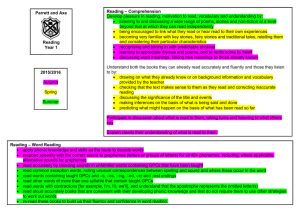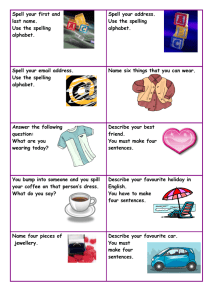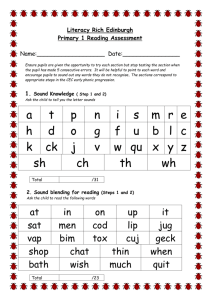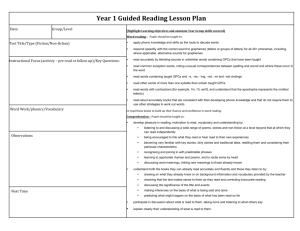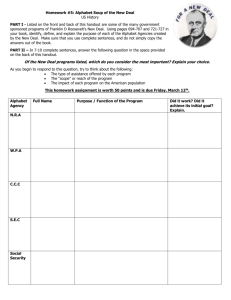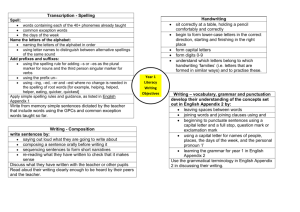Year 1 Programme of Study
advertisement
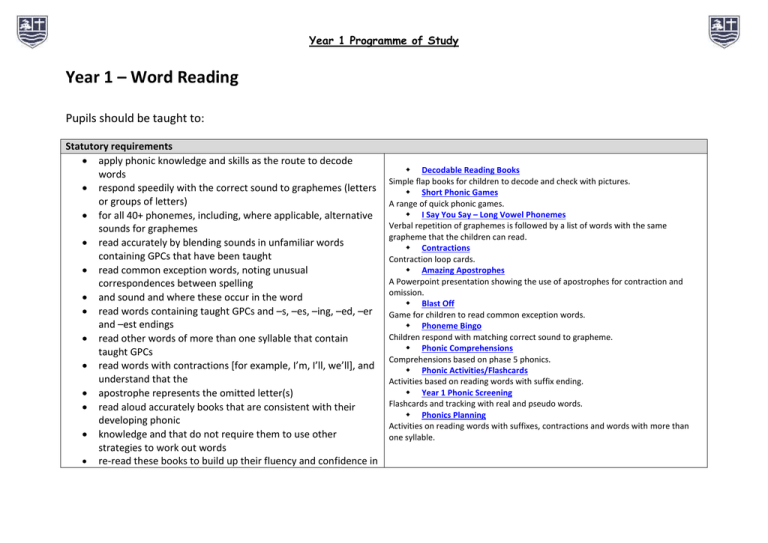
Year 1 Programme of Study Year 1 – Word Reading Pupils should be taught to: Statutory requirements apply phonic knowledge and skills as the route to decode words respond speedily with the correct sound to graphemes (letters or groups of letters) for all 40+ phonemes, including, where applicable, alternative sounds for graphemes read accurately by blending sounds in unfamiliar words containing GPCs that have been taught read common exception words, noting unusual correspondences between spelling and sound and where these occur in the word read words containing taught GPCs and –s, –es, –ing, –ed, –er and –est endings read other words of more than one syllable that contain taught GPCs read words with contractions [for example, I’m, I’ll, we’ll], and understand that the apostrophe represents the omitted letter(s) read aloud accurately books that are consistent with their developing phonic knowledge and that do not require them to use other strategies to work out words re-read these books to build up their fluency and confidence in Decodable Reading Books Simple flap books for children to decode and check with pictures. Short Phonic Games A range of quick phonic games. I Say You Say – Long Vowel Phonemes Verbal repetition of graphemes is followed by a list of words with the same grapheme that the children can read. Contractions Contraction loop cards. Amazing Apostrophes A Powerpoint presentation showing the use of apostrophes for contraction and omission. Blast Off Game for children to read common exception words. Phoneme Bingo Children respond with matching correct sound to grapheme. Phonic Comprehensions Comprehensions based on phase 5 phonics. Phonic Activities/Flashcards Activities based on reading words with suffix ending. Year 1 Phonic Screening Flashcards and tracking with real and pseudo words. Phonics Planning Activities on reading words with suffixes, contractions and words with more than one syllable. Year 1 Programme of Study word reading Year 1 Programme of Study Year 1 – Reading Comprehension Pupils should be taught to: Statutory requirements develop pleasure in reading, motivation to read, vocabulary and understanding by: o listening to and discussing a wide range of poems, stories and non-fiction at a level beyond that at which they can read independently o being encouraged to link what they read or hear read to their own experiences o becoming very familiar with key stories, fairy stories and traditional tales, retelling them and considering their particular characteristics o recognising and joining in with predictable phrases o learning to appreciate rhymes and poems, and to recite some by heart o discussing word meanings, linking new meanings to those already known Traditional Tales Resources looking at characters and settings of traditional tales. Traditional Stories Planning Planning based on the theme of ‘Once upon a time’. Red Riding Hood Retell A picture sequence activity and writing frame to get pupils to confidently retell the story of Red Riding Hood. Traditional Tales Quiz Interactive Powerpoint to cover aspects of traditional stories. Year 1 Programme of Study understand both the books they can already read accurately and fluently and those they listen to by: o drawing on what they already know or on background information and o using vocabulary provided by the teacher o checking that the text makes sense to them as they read and correcting o inaccurate reading o discussing the significance of the title and events o making inferences on the basis of what is being said and done o predicting what might happen on the basis of what has been read so far Guided Reading Cards Reading questions for pupils to answer as they engage with texts. Guided Reading Question Key Rings Questions to focus on inference and deduction. Reciprocal Reading Cards Encourages children to clarify, summarise, predict and question what they have read. AF3 Reading Question Spinner Deduction and inference questions. participate in discussion about what is read to them, taking turns and listening to what others say Three-week Scheme Based on Julia Donaldson A range of activities discussing work by the popular children’s author. Activities for Responding to Reading A range of activities based on books read to develop reading skills. Reading Follow Up Activities with AFs Selection of activities to use ranging from level 1-3. Reading Circle Reading activities to encourage reciprocal reading among peers. Year 1 Programme of Study explain clearly their understanding of what is read to them Reading Activities A range of activities based on stories read. Basic Comprehension Activities Children read simple sentences and draw what they read. Reading Activities Children to complete work either written or orally based on what they have read. Reading Journal Activities Activities to be completed independently or in pairs/groups. Year 1 Programme of Study Year 1 – Writing – Transcription Pupils should be taught to: Statutory requirements: spell: o words containing each of the 40+ phonemes already taught o common exception words o the days of the week name the letters of the alphabet: o naming the letters of the alphabet in order o using letter names to distinguish between alternative spellings of the same sound Days of the Week Flashcards/ handwriting for days of the week based on The Very Hungry Caterpillar. Common Exception Words Flashcards for use with your students. Words Containing 40+ Phonemes Flashcards for use with your students. Phonics Planning Phase 5 planning. Alphabet Arc Activities A range of activities, where children use the arc to help learn the order. Alphabet Line Upper-case and lower-case alphabet line. Alphabet Frieze This can be used on a display showing letter name and sound. Alphabet Order Song Learn and create a song based on ordering the alphabet. Year 1 Programme of Study add prefixes and suffixes: o using the spelling rule for adding –s or –es as the plural marker for nouns and the third person singular marker for verbs o using the prefix un– o using –ing, –ed, –er and –est where no change is needed in the spelling of root words [for example, helping, helped, helper, eating, quicker, quickest] apply simple spelling rules and guidance, as listed in English Appendix 1 write from memory simple sentences dictated by the teacher that include words using the GPCs and common exception words taught so far. Adding -s or -es A Powerpoint presentation and song to help teach the rule. Adding -un A Powerpoint presentation and revision guide. Using -er and -ing Whole-class IWB activities. Phase 6 Phonic Planning Planning, including teaching of suffixes. Consonant Cluster and Blends Flashcards to aid revision. Vowel Digraphs Range of phonic activities to teach/revise vowel digraphs. Spelling Handbook Teacher’s guide, including common spelling patterns, spelling games etc. Support for Spelling Planning Use to support planning of phase 6 phonics. Dictation Sentences Simple sentences for Year 1. Dictation Passage Based on phonics play to use as an assessment. Simple Sentences To use in dictation including CVC words. Year 1 Word List To use in dictation sentences. Year 1 Programme of Study Year 1 - Handwriting Pupils should be taught to: Statutory requirements: sit correctly at a table, holding a pencil comfortably and correctly begin to form lower-case letters in the correct direction, starting and finishing in the right place form capital letters form digits 0-9 understand which letters belong to which handwriting ‘families’ (ie, letters that are formed in similar ways) and to practise these Lower Case Letters Children can practise writing their letters using whiteboard pens. Handwriting Families Rhymes to help children remember which letters are similar. Capital Letters Practise sheet with lower case and capital letters. Writing Digits Toy-themed activity to show how to form digits. Year 1 Programme of Study Year 1 – Writing – Composition Pupils should be taught to: Statutory requirements: write sentences by: o saying out loud what they are going to write about o composing a sentence orally before writing it o sequencing sentences to form short narratives o re-reading what they have written to check that it makes sense o discuss what they have written with the teacher or other pupils o read aloud their writing clearly enough to be heard by their peers and the teacher Building Sentences Game Sentence-building game with four different levels. Improving Sentences Use this Powerpoint presentation to help children form and improve sentences together. Sentence Practice Writing sentences about pictures using given vocabulary. Questions and Sentences About Pictures The activity is to ask questions in a barrier game and select word cards to match the replies and build sentences. Year 1 Programme of Study Year 1 – Writing – Vocabulary, grammar and punctuation Pupils should be taught to: Statutory requirements: develop their understanding of the concepts set out in English Appendix 2 by: o leaving spaces between words o joining words and joining clauses using and o beginning to punctuate sentences using a capital letter and a full stop, question mark or exclamation mark o using a capital letter for names of people, places, the days of the week, and the personal pronoun ‘I’ o learning the grammar for year 1 in English Appendix 2 use the grammatical terminology in English Appendix 2 in discussing their writing Capital Letters – Different Uses A selection of activities to practise using capital letters in different ways. Kung Fu Punctuation Visual aid to teach punctuation based on Ros Wilson’s punctuation pyramid. VCOP Pyramid Helps children see what they need to do to improve their writing. Full-stop Ideas and Full-stop Badges Fun activities to help children to use full stops. Checking Writing Bookmarks to allow young children to check their writing Writing Progression Resource – SPaG Bank of activities and links to support writing development. VCOP Activities A range of quick activities and games to develop VCOP. Capital Letters and Full Stops Simple activities for children to practise the rules of punctuation. Introduction to Connectives Video and worksheet to introduce pupils to connectives.
